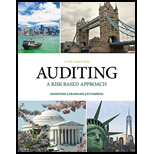
Auditing: A Risk Based-Approach (MindTap Course List)
11th Edition
ISBN: 9781337619455
Author: Karla M Johnstone, Audrey A. Gramling, Larry E. Rittenberg
Publisher: Cengage Learning
expand_more
expand_more
format_list_bulleted
Concept explainers
Question
Chapter 6, Problem 16CYBK
To determine
Introduction: It is about use of
It is to choose correct procedure among many procedure options which an auditor would like to perform to conclude at the reasonableness of management’s estimate of pension liability.
Expert Solution & Answer
Want to see the full answer?
Check out a sample textbook solution
Students have asked these similar questions
Can you explain this general accounting question using accurate calculation methods?
Help with accounting question
Please help me solve this general accounting question using the right accounting principles.
Chapter 6 Solutions
Auditing: A Risk Based-Approach (MindTap Course List)
Ch. 6 - Prob. 1CYBKCh. 6 - Prob. 2CYBKCh. 6 - Prob. 3CYBKCh. 6 - Which of the following statements is true...Ch. 6 - Prob. 5CYBKCh. 6 - Prob. 6CYBKCh. 6 - Prob. 7CYBKCh. 6 - Prob. 8CYBKCh. 6 - Prob. 9CYBKCh. 6 - Prob. 10CYBK
Ch. 6 - Prob. 11CYBKCh. 6 - Prob. 12CYBKCh. 6 - Prob. 13CYBKCh. 6 - Prob. 14CYBKCh. 6 - Prob. 15CYBKCh. 6 - Prob. 16CYBKCh. 6 - Prob. 17CYBKCh. 6 - Prob. 18CYBKCh. 6 - Prob. 19CYBKCh. 6 - Prob. 20CYBKCh. 6 - Prob. 1RQSCCh. 6 - Prob. 2RQSCCh. 6 - Prob. 3RQSCCh. 6 - Prob. 4RQSCCh. 6 - Refer to Exhibit 6.2 and describe the differences...Ch. 6 - Prob. 6RQSCCh. 6 - Prob. 7RQSCCh. 6 - Prob. 8RQSCCh. 6 - Prob. 10RQSCCh. 6 - Prob. 11RQSCCh. 6 - Prob. 12RQSCCh. 6 - Prob. 13RQSCCh. 6 - Prob. 14RQSCCh. 6 - Prob. 15RQSCCh. 6 - Indicate how the auditor could use substantive...Ch. 6 - Prob. 17RQSCCh. 6 - Prob. 18RQSCCh. 6 - Prob. 19RQSCCh. 6 - Prob. 20RQSCCh. 6 - Prob. 21RQSCCh. 6 - Prob. 22RQSCCh. 6 - Prob. 23RQSCCh. 6 - Prob. 24RQSCCh. 6 - Prob. 25RQSCCh. 6 - Prob. 26RQSCCh. 6 - Prob. 27RQSCCh. 6 - Prob. 28RQSCCh. 6 - Prob. 29FFCh. 6 - Prob. 30FFCh. 6 - Prob. 31FFCh. 6 - Prob. 32FFCh. 6 - Prob. 33FFCh. 6 - MINISCRIBE (LO 1, 2) As reported in the Wall...
Knowledge Booster
Learn more about
Need a deep-dive on the concept behind this application? Look no further. Learn more about this topic, accounting and related others by exploring similar questions and additional content below.Similar questions
- Nevaeh Manufacturing company has a beginning finished goods inventory of $16,200, cost of goods manufactured of $45,800, and an ending finished goods inventory of $18,500. The cost of goods sold for this company is: A. $37,300 B. $45,100 C. $43,500 D. $47,500 Zenith Enterprises has sales of $350,000, cost of goods sold of $190,000, net profit of $15,600, net fixed assets of $170,000, and current assets of $95,000. What is the total asset turnover rate?arrow_forwardI need help with this problem and accounting questionarrow_forwardPlease provide the accurate answer to this general accounting problem using appropriate methods.arrow_forward
- I need help with this general accounting question using standard accounting techniques.arrow_forwardCobalt Industries purchases a milling machine for $12,500. In addition, it incurs a sales tax of $600, shipping costs of $1,200, and $2,300 in labor costs to put the machine in place. The estimated residual value of the machine at the end of its useful life is $900. What is the depreciable base of the machine?arrow_forwardSubject: financial accountingarrow_forward
arrow_back_ios
SEE MORE QUESTIONS
arrow_forward_ios
Recommended textbooks for you
 Auditing: A Risk Based-Approach (MindTap Course L...AccountingISBN:9781337619455Author:Karla M Johnstone, Audrey A. Gramling, Larry E. RittenbergPublisher:Cengage Learning
Auditing: A Risk Based-Approach (MindTap Course L...AccountingISBN:9781337619455Author:Karla M Johnstone, Audrey A. Gramling, Larry E. RittenbergPublisher:Cengage Learning Auditing: A Risk Based-Approach to Conducting a Q...AccountingISBN:9781305080577Author:Karla M Johnstone, Audrey A. Gramling, Larry E. RittenbergPublisher:South-Western College Pub
Auditing: A Risk Based-Approach to Conducting a Q...AccountingISBN:9781305080577Author:Karla M Johnstone, Audrey A. Gramling, Larry E. RittenbergPublisher:South-Western College Pub

Auditing: A Risk Based-Approach (MindTap Course L...
Accounting
ISBN:9781337619455
Author:Karla M Johnstone, Audrey A. Gramling, Larry E. Rittenberg
Publisher:Cengage Learning

Auditing: A Risk Based-Approach to Conducting a Q...
Accounting
ISBN:9781305080577
Author:Karla M Johnstone, Audrey A. Gramling, Larry E. Rittenberg
Publisher:South-Western College Pub
